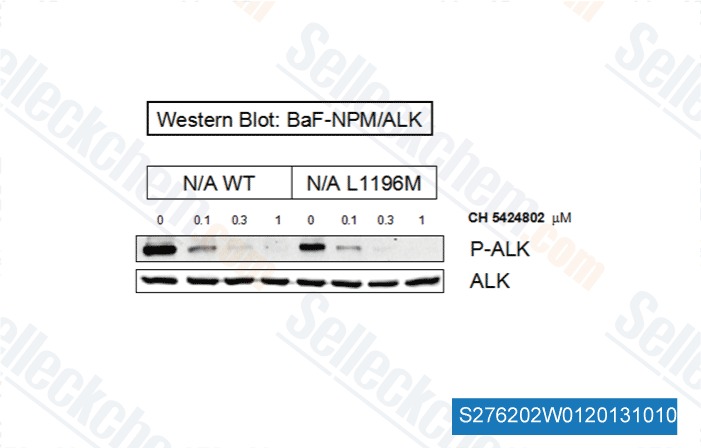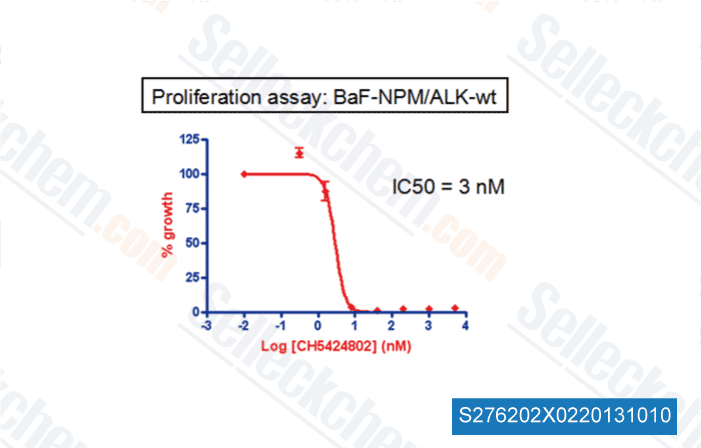|
Toll Free: (877) 796-6397 -- USA and Canada only -- |
Fax: +1-832-582-8590 Orders: +1-832-582-8158 |
Tech Support: +1-832-582-8158 Ext:3 Please provide your Order Number in the email. |
Technical Data
| Formula | C30H34N4O2 |
||||||
| Molecular Weight | 482.62 | CAS No. | 1256580-46-7 | ||||
| Solubility (25°C)* | In vitro | DMSO | 6 mg/mL (12.43 mM) | ||||
| Water | Insoluble | ||||||
| Ethanol | Insoluble | ||||||
| In vivo (Add solvents to the product individually and in order) |
|
||||||
|
* <1 mg/ml means slightly soluble or insoluble. * Please note that Selleck tests the solubility of all compounds in-house, and the actual solubility may differ slightly from published values. This is normal and is due to slight batch-to-batch variations. * Room temperature shipping (Stability testing shows this product can be shipped without any cooling measures.) |
|||||||
Preparing Stock Solutions
Biological Activity
| Description | Alectinib is a potent ALK inhibitor with IC50 of 1.9 nM in cell-free assays, sensitive to L1196M mutation and higher selectivity for ALK than PF-02341066, NVP-TAE684 and PHA-E429. | ||||||
|---|---|---|---|---|---|---|---|
| Targets |
|
||||||
| In vitro | The dissociation constant (KD) value of CH5424802 for ALK in an ATP-competitive manner is 2.4 nM. CH5424802 has substantial inhibitory potency against both native ALK and L1196M with Ki of 0.83 nM and 1.56 nM, respectively. CH5424802 prevents autophosphorylation of ALK in NCI-H2228 NSCLC cells expressing EML4-ALK. CH5424802 also suppresses the phosphorylation of STAT3 and AKT, but not of ERK1/2. CH5424802 completely inhibits the phosphorylation of STAT3 at Tyr705. CH5424802 is preferentially efficacious against NCI-H2228 cells expressing EML4-ALK, but not ALK fusion-negative NSCLC cell lines, including HCC827 cells (EGFR exon 19 deletion), A549 cells (KRAS mutant), or NCI-H522 cells (EGFR wild-type, KRAS wild-type, and ALK wild-type) in monolayer culture. CH5424802 elicits an apoptotic marker—caspase-3/7-like activation—in NCI-H2228 spheroid cells. CH5424802 blocks the growth of two lymphoma lines, KARPAS-299 and SR, with NPM-ALK fusion protein but does not influence the growth of an HDLM-2 lymphoma line without ALK fusion. [1] CH5424802 displays high target selectivity and the stronger anti-proliferative activity against KARPAS-299. CH5424802 inhibits KAPRAS-299 with an IC50 of 3 nM, and KDR with IC50 of 1.4 μM. The metabolic stability of CH5424802 is very high.[2] | ||||||
| In vivo | Oral administration of CH5424802 dose-dependently inhibits tumor growth with an ED50 of 0.46 mg/kg and tumor regression. Treatment of 20 mg/kg CH5424802 reveals rapid tumor regression by 168%, the tumor volume in any mouse is <30 mm3 after 11 days of treatment (at day 28), a potent antitumor effect is maintained, and tumor regrowth does not occur throughout the 4-week drug-free period. The half-life and the oral bioavailability of CH5424802 in mice are 8.6 hours and 70.8%, respectively. At a repeated dose of 6 mg/kg, the mean plasma levels reached 1.7, 1.5, and 0.3 nM at 2, 7, and 24 hours post-dose, respectively. Administration of CH5424802 leads to tumor growth prevention and tumor regression. Tumor growth inhibition at 20 mg/kg is 119% for KARPAS-299 and 104% for NB-1 on day 20. CH5424802 inhibits the phosphorylation of STAT3 in a dose-dependent manner (2–20 mg/kg). A partial decrease in AKT phosphorylation is also observed in CH5424802-treated xenograft tumors. [1] |
Protocol (from reference)
| Kinase Assay:[1] |
|
|---|---|
| Cell Assay:[1] |
|
| Animal Study:[1] |
|
References
|
Customer Product Validation

-
Data from [ Int J Oncol , 2014 , 45(4), 1430-6 ]

-
, , Prof. Gambacorti from Università degli Studi di Milano Bicocc

-
, , Prof. Gambacorti from Università degli Studi di Milano Bicocc

-
Data from [ , , Oncologist, 2017, 22(2):158-164 ]
Selleck's Alectinib Has Been Cited by 117 Publications
| RNase1-driven ALK-activation is an oncogenic driver and therapeutic target in non-small cell lung cancer [ Signal Transduct Target Ther, 2025, 10(1):124] | PubMed: 40246819 |
| Targeting proteostasis in multiple myeloma through inhibition of LTK [ Leukemia, 2025, 10.1038/s41375-025-02682-8] | PubMed: 40634511 |
| Novel selective strategies targeting the BCL-2 family to enhance clinical efficacy in ALK-rearranged non-small cell lung cancer [ Cell Death Dis, 2025, 16(1):194] | PubMed: 40113795 |
| Evaluation and modification of tumor cell isolation techniques from malignant effusions for rapid drug sensitivity testing [ Mol Oncol, 2025, 10.1002/1878-0261.70072] | PubMed: 40525275 |
| Ferristatin II protects nucleus pulposus against degeneration through inhibiting ferroptosis and activating HIF-1α pathway mediated mitophagy [ Int Immunopharmacol, 2025, 147:113895] | PubMed: 39752759 |
| Efficacy of amivantamab, a bi-specific antibody targeting EGFR and MET, in ALK-rearranged non-small-cell lung cancer cell lines [ Lung Cancer, 2025, 201:108415] | PubMed: 39922174 |
| A high-throughput screening platform to identify MYCN expression inhibitors for liver cancer therapy [ Front Oncol, 2025, 15:1486671] | PubMed: 40027135 |
| A high-throughput screening platform to identify MYCN expression inhibitors for liver cancer therapy [ Front Oncol, 2025, 15:1486671] | PubMed: 40027135 |
| Brigatinib activates inflammasomes: Implication for immune-related adverse events [ Toxicol Appl Pharmacol, 2025, 498:117310] | PubMed: 40122348 |
| PLCXD3-ALK, a novel ALK rearrangement in lung squamous cell carcinoma and its clinical responses to ALK inhibitors [ J Thorac Dis, 2025, 17(1):93-108] | PubMed: 39975736 |
RETURN POLICY
Selleck Chemical’s Unconditional Return Policy ensures a smooth online shopping experience for our customers. If you are in any way unsatisfied with your purchase, you may return any item(s) within 7 days of receiving it. In the event of product quality issues, either protocol related or product related problems, you may return any item(s) within 365 days from the original purchase date. Please follow the instructions below when returning products.
SHIPPING AND STORAGE
Selleck products are transported at room temperature. If you receive the product at room temperature, please rest assured, the Selleck Quality Inspection Department has conducted experiments to verify that the normal temperature placement of one month will not affect the biological activity of powder products. After collecting, please store the product according to the requirements described in the datasheet. Most Selleck products are stable under the recommended conditions.
NOT FOR HUMAN, VETERINARY DIAGNOSTIC OR THERAPEUTIC USE.
